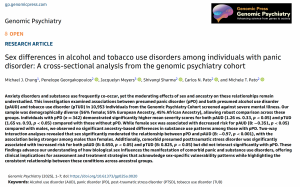
Sex differences drive substance use patterns in panic disorder patients

Professor Michele Pato, Rutgers University
A large-scale study has uncovered that males with panic disorder have substantially higher alcohol risk scores compared to females with the same conditions.
PISCATAWAY, NJ, UNITED STATES, April 22, 2025 /EINPresswire.com/ -- In a comprehensive Genomic Press peer-reviewed research article, researchers have revealed compelling evidence that biological sex significantly influences substance use patterns among individuals with panic disorder, with implications for both clinical assessment and treatment strategies.
The noteworthy study, published today in the journal Genomic Psychiatry, examined associations between panic disorder and both alcohol and tobacco use disorders in a demographically diverse sample of nearly 11,000 individuals. The research team, led by Dr. Michele Pato from Rutgers University, found that while panic disorder generally increased risk for problematic substance use, men with panic disorder showed dramatically higher alcohol risk scores than women with the same condition.
Key Findings
"Our findings demonstrate that sex plays a crucial moderating role in how panic disorder relates to alcohol use problems," said Professor Pato. "While females are generally more likely to experience panic disorder, males with the condition appear particularly more vulnerable to developing problematic drinking behaviors, potentially as a form of self-medication."
The study utilized data from the Genomic Psychiatry Cohort, a large-scale collection of individuals screened against severe mental illness. The sample's demographic diversity—56% female, with balanced representation of European (55%) and African (45%) ancestry—provided researchers with a unique opportunity to examine how these demographic factors might influence comorbidity patterns.
Contrary to some previous research, the study found no significant ancestry-based differences in substance use patterns among those with panic disorder. This suggests that the relationship between panic and substance use disorders remains consistent across these ancestral groups, despite known differences in overall prevalence rates.
Questions for Future Research
What specific neurobiological mechanisms might make males with panic disorder more susceptible to alcohol problems? Could hormonal factors be influencing these sex-based vulnerability patterns? These questions represent important directions for future research.
Implications for Co-morbid Conditions
The study also found that individuals with both panic disorder and posttraumatic stress disorder (PTSD) faced significantly higher risks for both alcohol and tobacco use disorders. This highlights the compounding effect of multiple anxiety conditions on substance use risk.
Clinical Significance
How might these findings reshape clinical approaches to treating panic disorder? Should clinicians implement more targeted screening for substance use problems, particularly among male patients with panic symptoms? The research suggests that sex-specific assessment and intervention strategies may be warranted.
"Understanding these sex-based vulnerability patterns has direct implications for how we screen for and treat comorbid conditions," noted Dr. Michael Chung, lead author and researcher at New York University Langone Medical Center. "Our work highlights the importance of considering biological sex when developing treatment plans for patients with panic disorder."
Innovative Methodology
The researchers employed a unique methodology, using screening items to identify "presumed" conditions rather than formal diagnostic assessments. This approach allowed them to examine relationships across a larger and more diverse sample than many previous studies.
Socio-cultural Considerations
What role might societal expectations around masculinity play in driving these sex differences? Are men with panic disorder less likely to seek professional help and more likely to self-medicate with substances? These sociocultural factors require further investigation to fully understand the observed patterns.
Conclusion
This research adds to a growing body of evidence suggesting that anxiety and substance use disorders share complex, bidirectional relationships that vary across demographic groups. The findings underscore the need for integrated treatment approaches that address both anxiety symptoms and substance use behaviors simultaneously.
The peer-reviewed study, "Sex differences in alcohol and tobacco use disorders among individuals with panic disorder: A cross-sectional analysis from the genomic psychiatry cohort," is available online in the journal Genomic Psychiatry at this url:
https://doi.org/10.61373/gp025a.0020.
The research was supported by the National Institute of Mental Health.
About Genomic Psychiatry – Genomic Psychiatry: Advancing Science from Genes to Society (ISSN: 2997-2388) represents a paradigm shift in genetics journals by interweaving advances in genomics and genetics with progress in all other areas of contemporary psychiatry. Genomic Psychiatry publishes peer-reviewed medical research articles of the highest quality from any area within the continuum that goes from genes and molecules to neuroscience, clinical psychiatry, and public health.
Media Contact: Media inquiries can be directed to Professor Michele Pato: mp1768@rwjms.rutgers.edu.
Dr. Michele Pato
Rutgers University
mp1768@rwjms.rutgers.edu
Visit us on social media:
Facebook
X
LinkedIn
Instagram
Other
Distribution channels: Culture, Society & Lifestyle, Food & Beverage Industry, Healthcare & Pharmaceuticals Industry, Science, Technology
Legal Disclaimer:
EIN Presswire provides this news content "as is" without warranty of any kind. We do not accept any responsibility or liability for the accuracy, content, images, videos, licenses, completeness, legality, or reliability of the information contained in this article. If you have any complaints or copyright issues related to this article, kindly contact the author above.
Submit your press release
